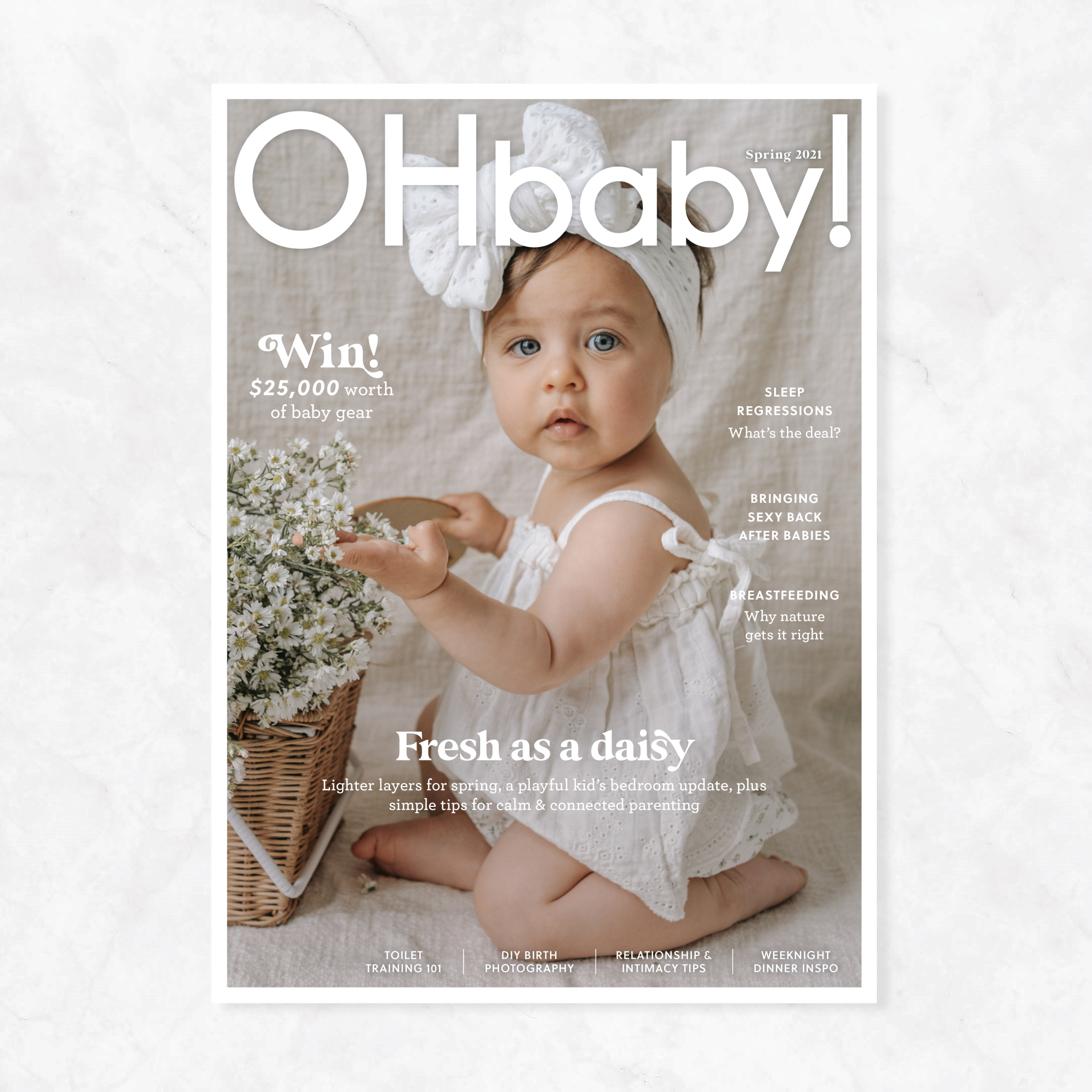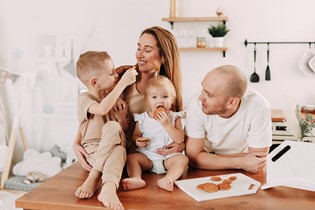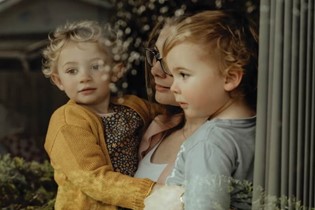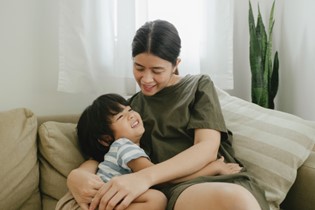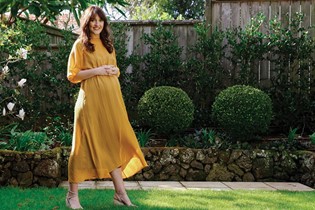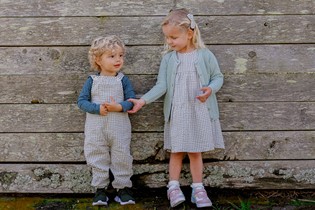Parenting course: Two vital ingredients that all kids need to thrive

This is part two of our three-part series introducing you to the brand new OHbaby! Renew Your Mind, Mindful Parenting Course. You can find part one here.
Developed with Chantal Hofstee, mum of three and clinical psychologist, the online course is split up into six practical sessions which teach techniques to help manage stress and resolve conflicts, increase connection in difficult times and create a calmer and happier home.
Read on for a taster of what you can expect from the course, and be sure to check back in next issue for part three.
We all want to be connected to our kids and for them to grow up to be healthy, resilient adults. Clinical psychologist and mum of three Chantal Hofstee explains the two vital ingredients all kids need to thrive
In my last article I introduced the concept of red-orange-green brain and how it relates to our parenting. This model of empowering ourselves to take greater control over our stress levels and manage them by figuring out what triggers and what reduces stress for us, and then taking strategic action in the form of introducing routines and strategies that promote green brain (low stress) and reduce red brain (high stress) has been so helpful for me personally in becoming the mother I want to be. Not just on the days when everything magically goes well, but also on those days when everything that could go wrong, does go wrong.
The other model that has profoundly shaped both my parenting and my work as a clinical psychologist, including my work with parents, is the model of the heart and the box. This simple yet profound model sums up the two fundamental ingredients any child needs for healthy brain development and to grow into a resilient and happy individual.
THE HEART
The heart stands for connection. Connection is our ability to tune into our children, really see and hear them. To be present with them and offer empathy and thoughtful responses, or sometimes simply them knowing we are available if they need us. Connection is not the same as quality time or interaction. It is your child knowing and feeling they are safe with you and that you will be available when they need you. This afternoon I was cleaning and tidying the house and my four-year-old was playing contentedly without any need for input from me. But as soon as she didn’t hear me anymore, her connection was ‘broken’ and she asked “Mummy, where are you?”. When I was back where she could hear me the connection was restored and she continued to happily play. My son will often ask for a cuddle when his ‘connection bucket’ is running on empty. I have learned that transitions drain him so offering a cuddle right before or after ‘transition time’ helps avoid meltdowns for him.
Lots of things can ‘break’ the connection from a child’s perspective, even when it is still fully intact from our perspective as a parent – making a phone call, leaving the room, being preoccupied or distracted, bedtime or going to school. The younger the child, the more physical closeness is needed for them to feel connected; as they grow older they learn we can be connected whilst apart. We call this ‘together apart’ but still kids often need their ‘connection buckets’ to be filled after a time of separation to feel fully connected again.
Apart from location and activities, there is another form of ‘disconnect’, which is when we, as parents, disconnect from our kids because of their emotions. For example, saying: “Stop being angry!”, “You are fine” (when your child is crying), or “It's not that bad.” Even though we mean well, we are breaking the connection by failing to meet them where they are at in that moment. Just imagine yourself coming home, close to tears, sharing with your partner or a friend something hurtful that happened at work and the response you get is “Don’t be sad, you are fine.” Or, after a long and hard day with the kids, your partner comes home and you share how your day was and they say “Next time you should just...”. When we are dismissed in our emotions, disconnection occurs.

Children are wired to always seek connection with their caregivers because it is their most important survival mechanism. This is why disconnect can be so upsetting to them and they might react with strong emotions; acting out or withdrawing when they feel disconnected from us. Every child is different in their connection needs and some need more ‘top ups’ throughout the day than others, but all children need to feel connected to at least one – but ideally more than one – reliable adult in their lives.
CONNECTION TIPS
- 2-5 minutes per child connection time in the mornings ensures they start the day ‘filled up’ Conscious connection time after school helps them transition and release their bottled up emotions from the day
- Bedtime connection. Take a few minutes to let them talk about whatever they want to share. No need for input from you, just active listening and affirmation
- Involve them in what you're doing
- Touch them often
- Really look them in the eye
- Keep your phone out of sight when you're with your children
THE BOX (BOUNDARIES)
The second fundamental ingredient for healthy brain development is boundaries. In parenting, this relies on our ability to set consistent, clear and predictable boundaries for our children. This brings safety and security and combined with connection, leads to green brain in children. Humans are incredibly resilient and can deal with great amounts of pressure and issues, but what research clearly shows is that the brain copes best with stress and pressure when it is predictable. What is predictable is manageable but as soon as it becomes unpredictable, stress levels go up drastically.

Life is full of unpredictable stresses – not making the team, not being invited to a birthday party, losing a game, not getting the grade you worked so hard for. If we, as parents, can bring consistency and predictability to the often emotionally chaotic worlds of our kids, we do their brain development a huge favour. It creates a solid and strong base from which they can explore the world and navigate it
with confidence.
Boundaries can refer to lots of different areas and will obviously change as your children grow. They include physical boundaries, for example where are they allowed to play? Are they allowed to sleep in your bed or not? They include rules around bedtime, screen-time and playtime. They include manners; what words are allowed and what words are not? The list goes on and on.
Whatever your style of parenting is, your child's brain craves consistency. When one night he is allowed to climb into bed with you but not the following night, then it is allowed the night after that, he will get confused which will lead to stress. If one day she gets a strong reaction from you when she says "Bumface" but the next day you think it's funny, you have just signed up for hearing a lot of that word. Children are driven to ‘look for the boundary,’ sometimes through challenging and disruptive behaviour. The clearer and more consistent you are, the less need for them to test you and the less stress is created for both parent and child.
BOUNDARY TIPS
- Have a family meeting where together you write up the family rules. Everyone gets a say in what the rules and the consequences/natural results of breaking the rules should be and why
- 3-6 rules is a good amount (keep it simple and concrete)
- Have everyone sign the family rules
- Put them on the fridge Refer back to them when needed Re-evaluate the rules together on a regular basis
CONNECTION + BOUNDARIES
Just like us adults, children react to many situations with stress which is taxing on their brains and disrupts optimal brain development. We don’t want to shield our children from all stress but we do want to provide them with the fundamental ingredients that will help them grow healthy and resilient brains. When we are able to provide connection and boundaries, our children can be in green brain and they can explore, learn and grow emotionally through the ups and downs. I sometimes picture this as a section with a boundary around it, with a warm and welcoming home in the center where our children can freely roam and explore the world, including its dangers , but can also always return home for emotional connection, reassurance and comfort when they need it. Always having strong and clear boundaries and staying connected is a utopia that none of us can live up to, but we can get better at it, especially when we know our own patterns and downfalls when it comes to the heart and the box.
WHEN YOUR CHILD GOES INTO RED BRAIN
When your child is emotional, acting out or withdrawing, ask yourself: what is under pressure? Is it the connection, the boundaries, or both?
- If it's the connection, consciously connect through:
- Touch: “Would you like a cuddle?”
- Eye contact and attention: “I'm listening/I'm here for you”
- Validation: “You seem very upset/angry/sad/frustrated etc, what's the matter?”
- Quality time: “Let’s play a game/read a book/drink some tea together/would you like to help me make the dinner?”
- If it's the boundaries, consciously set boundaries through:
- Reminding your child of your house rules
- Reminding your child of the consequences/natural results of breaking the house rules
- Clearly communicating what you want from your child
- Letting your child try again
- Following through with the consequences/natural results if that is what's needed
- If both connection and boundaries are lacking:
- Always start with connection (it often resolves the issue)
- If needed, follow the connection up with the boundaries (see step 2)
Look out in the next issue for part three in this series.
For more information on our OHbaby! Renew Your Mind, Mindful Parenting Course, visit ohbaby.co.nz/mindfulparenting.
Chantal Hofstee is the mindful mum of Sem, Isha & Leon, a clinical psychologist, an executive coach and the author of Renew Your Mind and Reach Your Goals Without Stressing Out. Find out more at renewyourmind.co.nz.

AS FEATURED IN ISSUE 55 OF OHbaby! MAGAZINE. CHECK OUT OTHER ARTICLES IN THIS ISSUE BELOW
